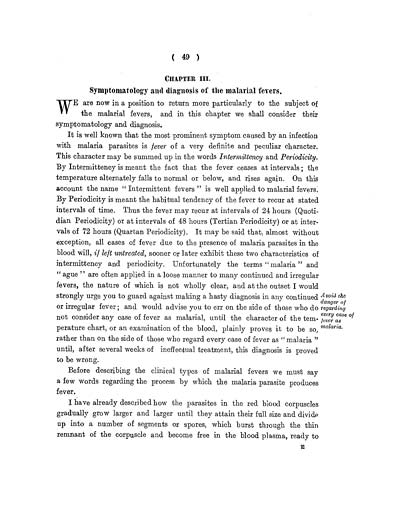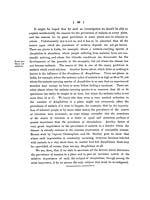Medicine - Disease > Malarial fevers
(59) Page 49
Download files
Individual page:
Thumbnail gallery: Grid view | List view

( 49 )
CHAPTER III.
Symptomatology and diagnosis of the malarial fevers.
Avoid the
danger of
regarding
every case of
fever as
malaria.
WE are now in a position to return more particularly to the subject of
the malarial fevers, and in this chapter we shall consider their
symptomatology and diagnosis.
It is well known that the most prominent symptom caused by an infection
with malaria parasites is fever of a very definite and peculiar character.
This character may be summed up in the words Intermittency and Periodicity.
By Intermittency is meant the fact that the fever ceases at intervals; the
temperature alternately falls to normal or below, and rises again. On this
account the name " Intermittent fevers " is well applied to malarial fevers.
By Periodicity is meant the habitual tendency of the fever to recur at stated
intervals of time. Thus the fever may recur at intervals of 24 hours (Quoti-
dian Periodicity) or at intervals of 48 hours (Tertian Periodicity) or at inter-
vals of 72 hours (Quartan Periodicity). It may be said that, almost without
exception, all cases of fever due to the presence of malaria parasites in the
blood will, if left untreated, sooner or later exhibit these two characteristics of
intermittency and periodicity. Unfortunately the terms "malaria" and
" ague " are often applied in a loose manner to many continued and irregular
fevers, the nature of which is not wholly clear, and at the outset I would
strongly urge you to guard against making a hasty diagnosis in any continued
or irregular fever; and would advise you to err on the side of those who do
not consider any case of fever as malarial, until the character of the tem-
perature chart, or an examination of the blood, plainly proves it to be so,
rather than on the side of those who regard every case of fever as " malaria "
until, after several weeks of ineffectual treatment, this diagnosis is proved
to be wrong.
Before describing the clinical types of malarial fevers we must say
a few words regarding the process by which the malaria parasite produces
fever.
I have already described how the parasites in the red blood corpuscles
gradually grow larger and larger until they attain their full size and divide
up into a number of segments or spores, which burst through the thin
remnant of the corpuscle and become free in the blood plasma, ready to
E
CHAPTER III.
Symptomatology and diagnosis of the malarial fevers.
Avoid the
danger of
regarding
every case of
fever as
malaria.
WE are now in a position to return more particularly to the subject of
the malarial fevers, and in this chapter we shall consider their
symptomatology and diagnosis.
It is well known that the most prominent symptom caused by an infection
with malaria parasites is fever of a very definite and peculiar character.
This character may be summed up in the words Intermittency and Periodicity.
By Intermittency is meant the fact that the fever ceases at intervals; the
temperature alternately falls to normal or below, and rises again. On this
account the name " Intermittent fevers " is well applied to malarial fevers.
By Periodicity is meant the habitual tendency of the fever to recur at stated
intervals of time. Thus the fever may recur at intervals of 24 hours (Quoti-
dian Periodicity) or at intervals of 48 hours (Tertian Periodicity) or at inter-
vals of 72 hours (Quartan Periodicity). It may be said that, almost without
exception, all cases of fever due to the presence of malaria parasites in the
blood will, if left untreated, sooner or later exhibit these two characteristics of
intermittency and periodicity. Unfortunately the terms "malaria" and
" ague " are often applied in a loose manner to many continued and irregular
fevers, the nature of which is not wholly clear, and at the outset I would
strongly urge you to guard against making a hasty diagnosis in any continued
or irregular fever; and would advise you to err on the side of those who do
not consider any case of fever as malarial, until the character of the tem-
perature chart, or an examination of the blood, plainly proves it to be so,
rather than on the side of those who regard every case of fever as " malaria "
until, after several weeks of ineffectual treatment, this diagnosis is proved
to be wrong.
Before describing the clinical types of malarial fevers we must say
a few words regarding the process by which the malaria parasite produces
fever.
I have already described how the parasites in the red blood corpuscles
gradually grow larger and larger until they attain their full size and divide
up into a number of segments or spores, which burst through the thin
remnant of the corpuscle and become free in the blood plasma, ready to
E
Set display mode to: Large image | Zoom image | Transcription
Images and transcriptions on this page, including medium image downloads, may be used under the Creative Commons Attribution 4.0 International Licence unless otherwise stated. ![]()
| India Papers > Medicine - Disease > Malarial fevers > (59) Page 49 |
|---|
| Permanent URL | https://digital.nls.uk/74558968 |
|---|---|
| Description | Chapter III.: Symptomatology and diagnosis of the malarial fevers |




